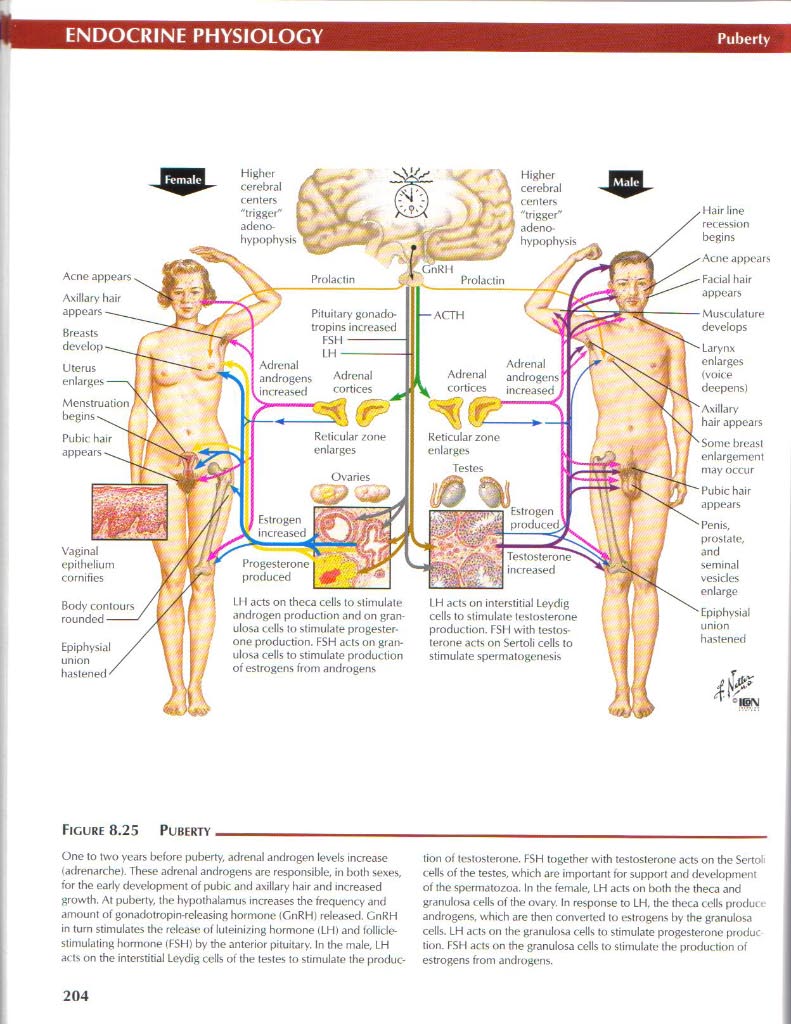netter185

Highcr
cerebral
centers
"trigger"
adeno-
hy|H>phv«s
Higher
cerebral
centers
"togger"
adeno
hypophysis
recession
begins
Acne appears
Prolactin
Prolaclir
Axillary hair
Breasts
develop
enlarges -
Menstruation begins \ ,
Yaginal
epilhelium
cornifies
Epiphysial hastened ^
• Acne appe
• Facial hair appears
Piluitary gonado-tropins increased FSH-
Adrenal
androgens
increased
Adrenal
cortices
Relicular <?one enlarges
Estrogen
increased
■ AfTH
Adrenal
cortices
Adrenal
androgens
increasedj
Musculature
develops
Larynx
enlarges
(voice
deepens)
Ovaries
Keticular zonę enlarges Testes
Estrogen
pmduced,
Progesteronc i ' 'JpK; produced \40j
I II acts on theca cells to stimulate androgen production and on gran-ulosa cells lo stimulate progester-one production. FSH acts on graiv ulosa cells to stimulate production of estrogens from androgens
Testosterone
increased
LH acts on interstitial Leydig cells lo stimulate testosterone production. FSII with testosterone acts on Sertoli cells to stimulate spermatogenesis
Axillary hair appeais
Sonie breast enlargement may occur
Pubie hair appears • Penis,
prostatę,
and
seminal
vesides
enlarge
• Epiphysial union hastened
Figurę 8.25 Puberty_
One to iwo years before puberty, adrenal androgen levels increase (adrenarchel. These adrenal androgens are responsible. in both sexes, for the early development of pubie and axillary liair and increased growth. At puberty, the hypothalamus increases the frequency and amount of gonadotropin-releasing hormone (GnRHl released. GnRH in tum stimulates the release of luteinizing hormone (LH) and follicłe-slimulating honnone (FSH) by the anterior pituitary. In the małe, LH acts on the interstitial Leydig cells of the testes to stimulate the production of testosterone. FSH together with testosterone acts on the Sertoli cells of the testes, which are important for support and devdopment of the spermatozoa. In the female, LH acts on l>oth the theca and granulosa cells of the ovary. In response to LH. the theca cells produi t-androgens, which are then converted to estrogens by the granulosa cells. LH acts on the granulosa cells to stimulate progesteronc produc tion. FSH acts on the granulosa cells to stimulate the production of estrogens from androgens.
204
Wyszukiwarka
Podobne podstrony:
netter165 ENDOCRINE PHYSIOLOGY Posterior Pituilary: Oxytocin Oxyto<in pickcd up by capillaries of
netter167 ENDOCRINE PHYSIOLOGY Growth Hormone Increased linear growth : Decreased adiposity Increase
netter178 Endocrine Pancreas Pancreatic islet A i - ot-), B : = p ), and D l =8 ) cells. 1. Reticulu
netter183 ENDOCRINE PHYSIOLOGY Gonad and Genital Duet Formation (pulled aside) I .‘rogemtoi•y Testos
10723 netter177 ENDOCRINE PHYSIOLOGY Adrenal Medulla CH/-CH-COOH ganglia CH7-CH2-N
32301 netter173 ENDOCRINE PHYSIOLOGY Adrenal Cortical Hormones JOMN A,CRAC_ao -IBM fe &n
więcej podobnych podstron